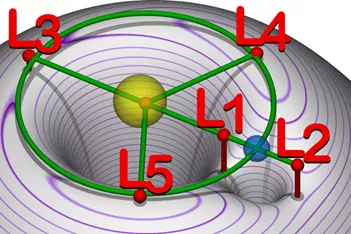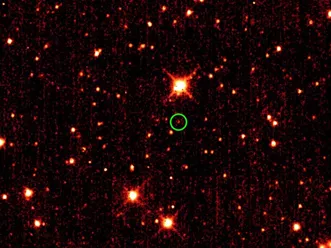Which Lagrange Point Do We Park a Satellite at to Make Continuous Observations of the Sun
Being one million miles from home is no small feat. In fact, it took NOAA's Deep Space Climate Observatory, or DSCOVR , over 100 days to traverse that distance and reach this unique vantage point.
Why send a satellite to deep space?
DSCOVR, NOAA's first deep space satellite, occupies a special orbit. Called Lagrange point 1, or simply L1, this halo like orbit is a neutral gravity point, requiring fewer orbital corrections, allowing DSCOVR to use less fuel and remain in its operational location for much longer.
L1 orbit keeps DSCOVR directly inline between the sun and Earth at all times. From here the satellite can provide advanced solar measurements and early warnings of potentially dangerous space weather events , acting as a solar storm buoy in deep space.
Stable orbit at L1 is possible thanks to a wonderful trick of physics. In fact, L1 is not the only one of these special locations around the sun and Earth. There are actually five of them and they can occur between any two massive objects!

This graphic shows the gravitational potential of objects in space (a planet shown in blue and the orbiting a star in yellow) and the points of equilibrium created between them. You can see the potential for an object to fall out of orbit at L1, L2 and L3 clearly. Credit: cmglee
These locations are named after Joseph-Louis Lagrange, the 18th-century mathematician who wrote about them in a 1772 paper explaining what he referred to as the "three-body problem."
They occur in space when the combined gravitational forces of two large objects equal the centrifugal force felt by a third smaller object. The interaction of these forces creates a point of equilibrium known as a Lagrange point.
Think of them as orbital parking spots. Things put at these locations tend to stay there thanks to a balancing act between gravity and the centrifugal force.
Imagine a spacecraft leaving Earth and rocketing toward the moon. As it hurtles through space, fighting to escape Earth's gravity, it will experience less and less of its pull. As the rocket nears the moon its gravity will become the dominate force, pulling the spacecraft toward it faster than Earth can pull it back; a sort of cosmic tug-of-war.
As this transition begins, the spacecraft will experience a moment of neutral gravity when the pull from the moon equals that of Earth's. When these forces balance against the centrifugal force, which is trying to fling the spacecraft off into space as it orbits, they cancel creating a Lagrange point.
Points of Lagrange are important because they allow for orbital periods equal to Earth's, even at varying distances.

Asteroid 2010 TK7 is circled in green, in this single frame taken by NASA's Wide-field Infrared Survey Explorer, or WISE. Credit: NASA
Spacecraft at L2 are best utilized for deep space observations, such as looking at the distant universe, because they always keep Earth and the Sun behind them. L1 is most often used for solar observations because of its uninterrupted view of the sun. And while no scientific uses for L3 exist currently because of communication issues with its location behind the sun, it is often regarded in science fiction as the location of the mysterious Planet X, hidden on the far side of the sun.
L1, L2, and L3 are all unstable points of equilibrium. Objects at these points are balanced between the acting forces but are in constant peril of drifting too far one way or the other, causing them to fall in faster and faster towards the sun or Earth. It is similar to a ball balanced on a hill. Minor adjustments are needed to keep it from rolling down one side or the other.
L4 and L5, however, are a bit different. They are completely stable locations lying along one object's orbit at 60 degrees ahead or behind, always forming the apex of two equilateral triangles with the massive objects as their vertices (see Figure 1). Objects in these locations actually have trouble falling out of orbit and act like a ball in a large curved bowl.
L4 and L5 can even collect and trap large space debris, such as asteroids. The gravitationally dominant Jupiter-sun system has thousands of these asteroids, called trojans. In 2011, NASA announced the discovery of the first Earth trojan at L4, called 2010 TK7.
preussfornevenithe.blogspot.com
Source: https://www.nesdis.noaa.gov/news/points-of-lagrange-satellite-million-miles-home
0 Response to "Which Lagrange Point Do We Park a Satellite at to Make Continuous Observations of the Sun"
Post a Comment